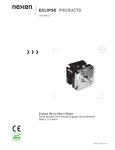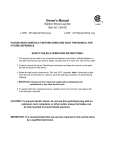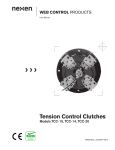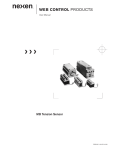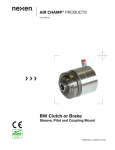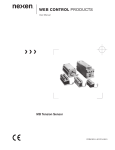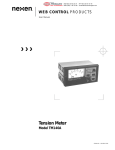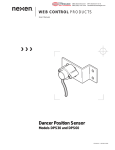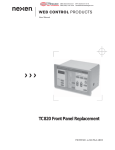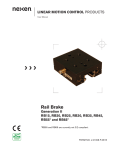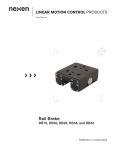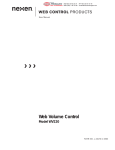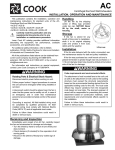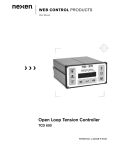Download Electric Rail Brake
Transcript
LINEAR MOTION CONTROL PRODUCTS User Manual Electric Rail Brake RBE Series FORM NO. 21254-A-0307 In accordance with Nexen’s established policy of constant product improvement, the specifications contained in this manual are subject to change without notice. Technical data listed in this manual are based on the latest information available at the time of printing and are also subject to change without notice. Technical Support: 800-843-7445 (651) 484-5900 www.nexengroup.com DANGER Read this manual carefully before installation and operation. Follow Nexen’s instructions and integrate this unit into your system with care. This unit should be installed, operated and maintained by qualified personnel ONLY. Improper installation can damage your system or cause injury or death. Comply with all applicable codes. Nexen Group, Inc. 560 Oak Grove Parkway Vadnais Heights, Minnesota 55127 ISO 9001 Certified Copyright 2007 Nexen Group, Inc. FORM NO. 21254-A-0307 Table of Contents Installation -----------------------------------------------------------------------------------------------------------------------------4 Wiring Installation Guidelines ---------------------------------------------------------------------------------------------5 Electrical Connections ------------------------------------------------------------------------------------------------------5 Engaged Output Signal Connection Diagrams---------------------------------------------------------------------6 Mounting RBE on a Rail-----------------------------------------------------------------------------------------------------7 Operation ------------------------------------------------------------------------------------------------------------------------------8 Friction Shoe Service -------------------------------------------------------------------------------------------------------------9 Warranty -----------------------------------------------------------------------------------------------------------------------------10 FORM NO. 21254-A-0307 INTRODUCTION The Nexen Electric Rail Brake (RBE) is for use on profile guide rails. This brake features 24 VDC operation, ease of control, engagement feedback, and visual indication of brake status. Indicators on the RBE inform the user of rail engagement and fault or service indications. INSTALLATION CAUTION CAUTION Mount in a shock and vibration free area with an ambient temperature greater then 0°C [32°F] and less than 60°C [140°F]. The RBE is for indoor use only. Dynamic applications, including emergency stops, are not recommended with the Nexen RBE. Minimize linear travel of RBE when engaging and disengaging. FORM NO. 21254-A-0307 Wiring installation guidelines This product is designed to minimize the effects of ElectroMagnetic Interference (EMI) on its operation, but as with any electronic device, proper installation and wiring methods are necessary to ensure proper operation. By doing so, the interference from external effects such as electrical line spikes, electrical noise, static electricity, etc. will be minimized. The following methods outline wiring installation guidelines to protect your system: • All input and output signal and sensor cables must be shielded with the shields tied to earth ground at one end. In case of very high frequency (MHz range) electrical noise, both ends of the shield need to be tied to earth ground. • Keep cable length and unshielded leads as short as possible. Think of them as antennae for noise. • Use power line filters to suppress interference on the AC voltage lines that power the unit. • • Isolate signal and sensor cables from cables carrying AC voltages, power for high current loads or relays and solenoids. Either relocate the signal and sensor cables away from other cables or use grounded metal conduits to shield them. This will reduce the potential for noise interference between the signal and sensor cables and the other noisy cables. Relay R Place a resistor-capacitor network (snubber) across inductive coils such as relays and solenoids in order to stop electrical interference at the source (See Figure 2). Snubber C Figure 2 Snubber applied across relay coil For environments that experience high levels of static electricity follow these additional guidelines: • Remove the static charge from material carrying it. In the case of webs that carry static charges, there are static charge removal products available such as static bars and ionized blowers. • Ensure that sensors and machine frames are grounded to earth through a low impedance path. • Wrap grounding tinsel around sensors and cables that are close to the source of the static electricity and ground the tinsel to earth. • Tie all signal and sensor cable shields directly to earth ground without passing through the electronic device. This will help prevent high voltage interference from coupling into other circuits within the device. Electrical Connections Cable Wires Function Brown +24 VDC & Common: RBE requires 24VDC to operate (Refer to SPECIFICATIONS for current rating). Blue DC Common White Engagement Input Signal: Applying 24 VDC to this input will cause RBE to disengage from rail. Removing all voltage from this input will cause RBE to engage rail. Black RBE Engaged Output Signal: This is an open collector transistor output (Refer to SPECIFICATIONS for ratings) that signals when RBE engages the rail. Transistor is switched on while RBE is engaged and is off while RBE is disengaged. Table 1 FORM NO. 21254-A-0307 ELECTRICAL CONNECTIONS RBE ENGAGED OUTPUT SIGNAL CONNECTION DIAGRAMS User Supplied Engaged Output Tied to PLC Input VD C (See Specifications for maximum voltage.) R (See Note.) RBE Black To PLC Input Blue VD C Common User Supplied NOTE: The minimum value of resistor (R) is 10 x VDC. User Supplied Engaged Output Tied to External Indicator External Indicator (See Note) RBE R Black VD C (See Specifications for maximum voltage and current ratings.) Blue VD C Common User Supplied NOTE: The minimum value of Resistor (R) is equal to VDC divided by the maximum current limit of the indicator. Be sure current requirement of External Indicator does not exceed capability of RBE output. User Supplied Engaged Output Tied to External Inductive Coil (See Notes) External Coil RBE Black VD C (See Specifications for 1N00 Blue maximum voltage and current ratings.) VD C Common User Supplied Figure 3 NOTES: 1. Be sure current requirement of External Coil does not exceed capability of RBE output. . Any inductive load, such as a relay coil, must have a 1N00, or equivalent, diode across it as shown. FORM NO. 21254-A-0307 Mounting RBE on A RAIL NOTE: The RBE Rail Brake friction shoe gap is set at the factory to accommodate specific rails and is not adjustable. Visit www.nexengroup.com for RBE dimensional drawing showing mounting dimensions. NOTE: The RBE Rail Brake does not have an internal bearing system, so it must be used in conjunction with at least two bearing carriages. Bearing* (2x min.) NOTE: RBE must be protected from effects of Electrostatic Discharge (ESD). To ensure proper operation, a low impedance path from the RBE housing to earth ground is required. Rail Brake 1. Pull out RBE from shipping box and remove shoe retaining foam from between shoes. Visually confirm that both shoes are present as shoes can fall out if RBE is handled abruptly while unmounted. Rail* Bearing* Figure 4 *Customer Supplied 2. Before locating RBE on a rail, provide 24 VDC power to RBE (Refer to ELECTRICAL CONNECTIONS). Note that shoes move toward each other. RBE will not fit on to rail in this condition. Mounting Fasteners* 3. Apply 24 VDC to White wire. Next, push shoes back into housing with finger to ensure adequate opening between them to accommodate rail. 4. Slide RBE onto rail and position it underneath the mounting plate (See Figure 4). Using customer supplied fasteners (See Figure 5 and Table 2), finger tight both RBE to mounting plate and mounting plate to bearing carriages. Mounting Plate* 5. Engage RBE to rail by removing 24 VDC from White wire. Note that RBE Engaged indicator is lit (See Figure 6). Figure 5 *Customer Supplied 6. After engagement, tighten all fasteners (See Figure 5). RBE Rail Brake Fastener Requirements Model Fastener Size Qty. RBE 25 M6 x 1.0 2 Table 2 FORM NO. 21254-A-0307 OPERATION Power is required anytime the RBE is to change state from engaged to disengaged, or, disengaged to engaged. Otherwise, power can be removed and the RBE will remain engaged or disengaged. Service Indicator After applying power, RBE will look at Engagement Input Signal. If the signal has 24 VDC applied to it, then RBE will disengage from rail. Or if the signal has 0 VDC applied to it, then RBE will engage rail. RBE Engaged Output Signal can be monitored for verification that RBE has engaged or disengaged rail. After engaging rail, RBE Engaged Output Signal’s transistor will turn on, dropping this signal’s voltage to less than one volt. In addition, the RBE Engaged Indicator will illuminate for the entire time RBE has engaged rail. RBE Engaged Indicator Figure 6 After disengaging rail, RBE Engaged Output Signal’s transistor will turn off, causing this signal’s voltage to be pulled up by the customer supplied pull up resistor and source. In addition, the RBE Engaged Indicator will turn off for the entire time RBE is disengaged from rail. Blinks Meaning “none” RBE operation is normal 1 Engagement timer expired Service Indicator 2 Excessive motor current A Service Indicator (See Figure 6) provides visual indication for troubleshooting and service issues. This indicator will blink if an engagement fault is encountered or if RBE needs serviced. The number of blinks corresponds to the event (See Table 3). 3 Low motor torque 4 Shoes have backed away from rail 5 RBE did not clamp on rail 6 Thermal limit exceeded 7 Time to rotate shoes In case of 1-6 blinks, RBE may not be clamped onto rail and requires attention by the customer to resolve any issues. Also, the RBE Engaged Output Signal will go to a voltage high state and RBE Engaged Indicator will turn off. These conditions are cleared automatically after a successful engagement. 8 RBE requires servicing Table 3 In case of 7 blinks, this indicates it is time to rotate the shoes, refer to SERVICE INSTRUCTIONS section. This indicator will continue to blink for 10,000 engagements and then automatically turn off. In case of an engagement fault, the indicator will give priority to fault indication and then revert back to service indication after the fault is resolved. In case of 8 blinks, this indicates the RBE’s service life has been reached and RBE needs to replaced or returned to Nexen Group, Inc for rebuilding. Once this limit has been reached, then RBE Engaged Output Signal will always be at a voltage high thus denying engagement feedback. FORM NO. 21254-A-0307 Friction Shoe sERVICE NOTE: There are no serviceable parts, excluding shoe, within the RBE Rail Brake. Nexen recommends that the RBE be returned to Nexen Group, Inc. for servicing. Do not attemp to remove or dismantle any part of the RBE assembly. In the case of an RBE malfunction or service problem, contact Nexen Customer Service. DANGER RBE End Cap Secure the load before disengaging the RBE. Failure to support the load may result in serious injury or death after the RBE releases the rail. V Position Mark V Friction Shoe Service Procedure 1. Secure the load from moving and then remove RBE mounting fasteners. The RBE is now free of the mounting plate. 2. Apply 24 VDC to the White wire to disengage RBE from rail. 3. Slide RBE off of rail. 4. Inspect the shoes for wear and damage. Normal witness marks will not exceed 0.03mm (.001 inch) in depth where the shoes contact the rail. If the shoes are worn beyond this point, or other damage exists, contact Nexen. 5. Mark position of shoes (See Figure 7) with a permanent marker. 6. Remove shoes. 7. Clean and re-lubricate shoes with the following approved greases, being careful not to clean off mark from step 4. Friction Shoe Rotate Shoe180 Mark in new position o V Figure 7 Approved Shoe Greases (customer supplied): • Chevron SRI 2 • Exxon Polyrex • Nippon Oil FNS 8 Rotate shoes 180 degrees from position in step 4. 9. Install shoes into RBE. 10. Clean lubricant from exposed surface of shoe. 11. Re-install RBE (Refer to RBE MOUNTING section). Specifications Power Supply 24 VDC +/- 5% RBE25: 24 VDC @ 2.5 A peak Cycle Rate One engagement or disengagement per second, maximum Ambient Temperature 0o - 60o C [32o - 140o F] Rotate Shoes Every 100,000 engagements Engagement Input 0-5 VDC – engage 15-24 VDC – disengage Service Life 225,000 engagements RBE Engaged Output Open Collector NPN Transistor I maximum = 100 mADC VLOW = 1 V maximum@50 mA VHIGH = 24 VDC maximum Holding Force 1000 N [225 lbs] maximum Response Time .45 seconds minimum to engage .15 seconds minimum to disengage Backlash at Rated Holding Force 0.30mm [.012 in] FORM NO. 21254-A-0307 Table 4 WARRANTY Warranties Nexen warrants that the Products will be free from any defects in material or workmanship for a period of 12 months from the date of shipment. NEXEN MAKES NO OTHER WARRANTY, EXPRESS OR IMPLIED, AND ALL IMPLIED WARRANTIES, INCLUDING WITHOUT LIMITATION, IMPLIED WARRANTIES OF MERCHANTABILITY AND FITNESS FOR A PARTICULAR PURPOSE ARE HEREBY DISCLAIMED. This warranty applies only if (a) the Product has been installed, used and maintained in accordance with any applicable Nexen installation or maintenance manual for the Product; (b) the alleged defect is not attributable to normal wear and tear; (c) the Product has not been altered, misused or used for purposes other than those for which it was intended; and (d) Buyer has given written notice of the alleged defect to Nexen, and delivered the allegedly defective Product to Nexen, within one year of the date of shipment. Exclusive Remedy The exclusive remedy of the Buyer for any breach of the warranties set out above will be, at the sole discretion of Nexen, a repair or replacement with new, serviceably used or reconditioned Product, or issuance of credit in the amount of the purchase price paid to Nexen by the Buyer for the Products. Limitation of Nexen’s Liability TO THE EXTENT PERMITTED BY LAW NEXEN SHALL HAVE NO LIABILITY TO BUYER OR ANY OTHER PERSON FOR INCIDENTAL DAMAGES, SPECIAL DAMAGES, CONSEQUENTIAL DAMAGES OR OTHER DAMAGES OF ANY KIND OR NATURE WHATSOEVER, WHETHER ARISING OUT OF BREACH OF WARRANTY OR OTHER BREACH OF CONTRACT, NEGLIGENCE OR OTHER TORT, OR OTHERWISE, EVEN IF NEXEN SHALL HAVE BEEN ADVISED OF THE POSSIBILITY OR LIKELIHOOD OF SUCH POTENTIAL LOSS OR DAMAGE. For all of the purposes hereof, the term “consequential damages” shall include lost profits, penalties, delay images, liquidated damages or other damages and liabilities which Buyer shall be obligated to pay or which Buyer may incur based upon, related to or arising out of its contracts with its customers or other third parties. In no event shall Nexen be liable for any amount of damages in excess of amounts paid by Buyer for Products or services as to which a breach of contract has been determined to exist. The parties expressly agree that the price for the Products and the services was determined in consideration of the limitation on damages set forth herein and such limitation has been specifically bargained for and constitutes an agreed allocation of risk which shall survive the determination of any court of competent jurisdiction that any remedy herein fails of its essential purpose. Limitation of Damages In no event shall Nexen be liable for any consequential, indirect, incidental, or special damages of any nature whatsoever, including without limitation, lost profits arising from the sale or use of the Products. Warranty Claim Procedures To make a claim under this warranty, the claimant must give written notice of the alleged defect to whom the Product was purchased from and deliver the Product to same within one year of the date on which the alleged defect first became apparent. Nexen Group, Inc. 560 Oak Grove Parkway Vadnais Heights, MN 55127 800.843.7445 Fax: 651.286.1099 www.nexengroup.com ISO 9001 Certified FORM NO. 21254-A-0307 10










